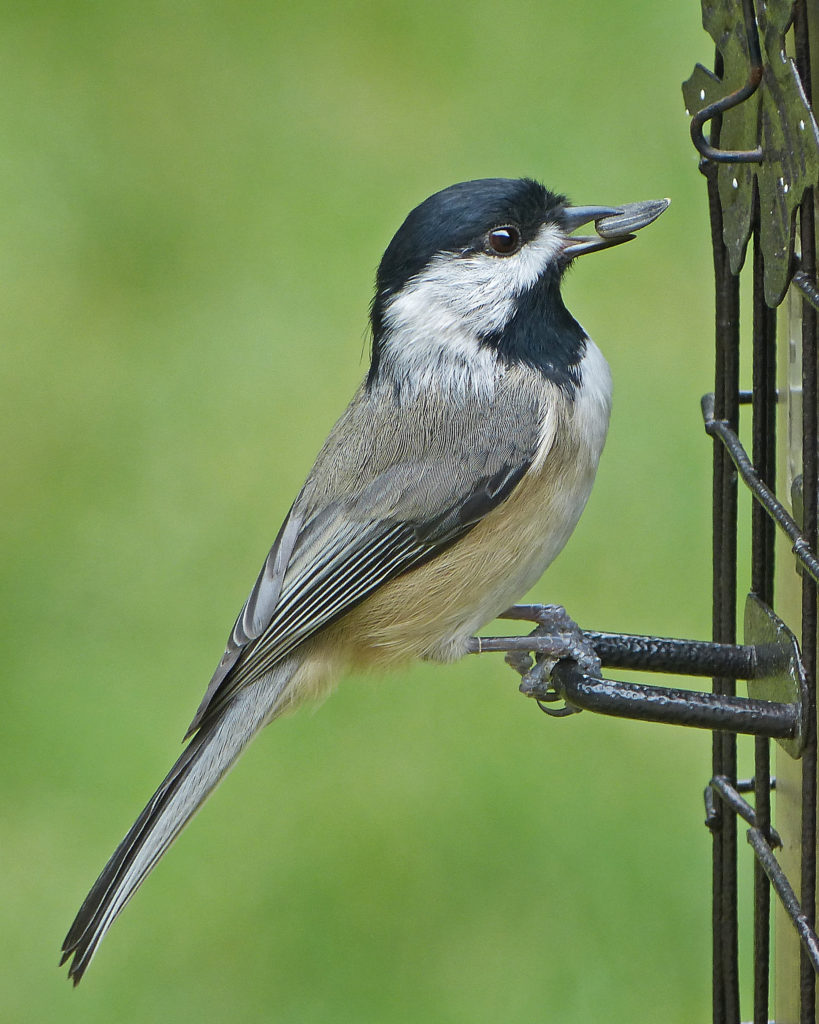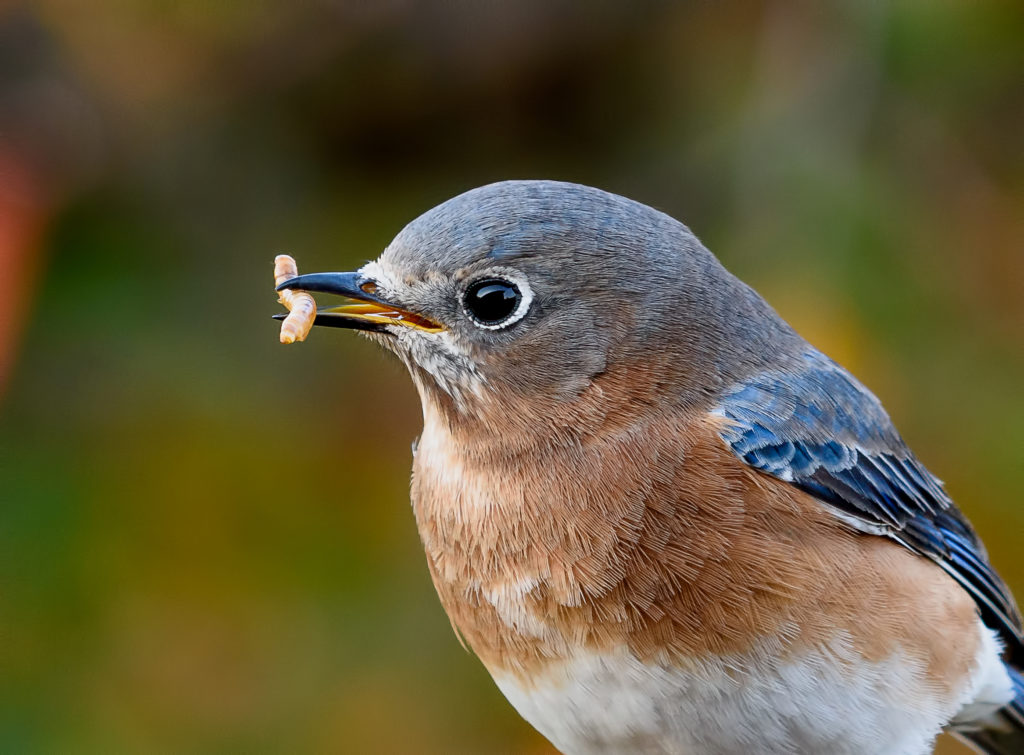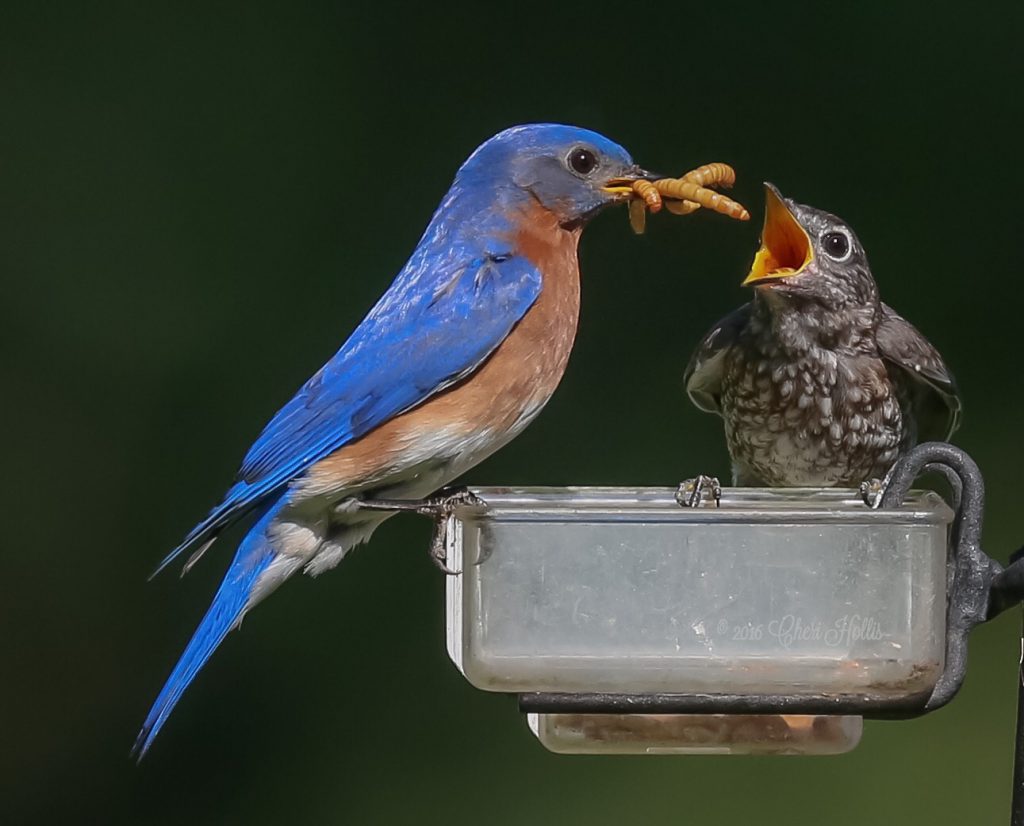 Photo ©
Deb Winter
Photo ©
Deb Winter
By Robyn Bailey, NestWatch Project Leader
Wild bird feeding is one of North America’s largest undirected ornithological “experiments,” one in which many of us willingly participate because it is a simple way to nurture our backyard birds. In the United States, more than 59 million people feed birds around the home (U.S. Department of the Interior et al. 2018). Beginning in 2014, NestWatch organized one of the largest studies of supplemental feeding of breeding birds, simply by asking participants to report whether or not they offered supplemental food to nesting bluebirds and chickadees (all species). After delving into the data collected from 2014–2019, we were able to analyze 24,528 nest records of Eastern Bluebirds, Black-capped Chickadees, and Carolina Chickadees submitted by citizen scientists from Alaska to Florida. We sought to answer the question of how feeding wild birds impacts their reproductive success on this grand scale.

Seed Savers Club
Chickadees, like this Carolina Chickadee, are known to "cache" seeds (that is, hide them for later retrieval). This behavior helps them survive when food is less plentiful.
In this recently published study (Bailey and Bonter 2021), Eastern Bluebirds were considered supplemented if they were offered insect larvae (e.g., mealworms or waxworms), whereas the chickadees were considered supplemented if they were provided seeds, suet, insect larvae, or fruit. NestWatchers also reported when they made food available (i.e., before eggs were laid, when eggs were present, and/or when nestlings were present) so that we could determine if a nest was supplemented during the relevant time period.
Timing of egg-laying
Our analysis revealed that Eastern Bluebirds with access to additional food laid eggs nearly 6 days earlier than those without; however, chickadees did not lay eggs any earlier when they were offered food. Laying eggs earlier could be an advantage for bluebirds if it allows them to produce an additional clutch later in the season. However, there is a risk that they could nest too early and encounter lethally cold weather in the early spring (Pinkowski 1977). We are not sure why chickadees didn’t nest any earlier when food was available, but it’s possible that they rely on other cues to decide when to lay eggs.
Clutch size
Eastern Bluebirds and both species of chickadees held steady in their clutch size, even with additional food on offer. Other factors were more strongly correlated with clutch size, such as latitude, longitude, and how late in the breeding season the eggs were laid. For example, Black-capped Chickadee clutch sizes increased from south to north, whereas Eastern Bluebird clutch sizes decreased. Both Carolina Chickadees and Eastern Bluebirds increased their clutch sizes from east to west. Our three focal species tended to lay smaller clutches later in the season. For Eastern Bluebirds with access to extra food, there was a small increase in clutch size for those late clutches, suggesting that supplementation can reduce this downward trend in clutch size as the season progresses. However, because both chickadee species rarely lay a second clutch, they essentially put all of their eggs in one basket.

Mealworms On The Menu
Mealworms are increasingly fed to bluebirds and other species, but some argue that the extra food might be "too much of a good thing."
Nest survival
This analysis took into account the presence or absence of predator guards, which are correlated with increased nest survival (Bailey and Bonter 2017). For an average Eastern Bluebird nest with a predator guard, nest survival was improved by about 5% overall when food was available. Our results suggested that for nests which make it to the nestling period, feeding bluebirds may be particularly helpful in the earlier part of the breeding season, when nestlings may be vulnerable to early spring cool weather. Nevertheless, unsupplemented Eastern Bluebirds still had very high nest success, suggesting that they survive quite well in nest boxes with predator guards even without human-provided food. Black-capped and Carolina Chickadees, on the other hand, did not have higher nest survival when supplemental food was available. This suggests that other factors (e.g., predators, competitors) may impact chickadee nest survival more than food availability.
Nestling mass
Because NestWatchers are not able to handle nestlings without special permits, we also undertook a concurrent study in Tompkins County, New York, to investigate whether supplemental feeding of 10 g of mealworms per nest per day increased nestling mass of Eastern Bluebirds and Black-capped Chickadees (Dzielski et al. 2021). This was a smaller study involving just two years of data, but the results were nevertheless consistent with the findings from the national study.
From the smaller study in upstate New York, we found that Eastern Bluebirds produced nestlings which were 5.2% heavier as they approached fledging age when given extra food. Previous research on songbirds suggests that first year survival is better for relatively heavy fledglings than for lean fledglings, suggesting that bluebird nestlings with access to supplemental food may have better prospects in life. Black-capped Chickadees, once again, did not benefit even though we provided live mealworms at nest boxes. We were unable to investigate Carolina Chickadees because they do not nest in upstate New York.

Dietary Generalists
In all four reproductive measures studied, no improvements (or detriments) were seen for chickadees which had access to human-provided food.
Lessons learned
Bluebirds and chickadees are among the most likely species to be supplemented with both food and nesting cavities in North America, so it makes sense that we would examine these species using our citizen-science platform. We did not expect the results to differ so much between the chickadees and the bluebirds, but we can speculate as to why they did. Eastern Bluebirds have a more limited diet, eating primarily insects and fruit. Chickadees of both species exploit a wider variety of foods, and therefore may not be as sensitive to food shortages during the breeding season. However, our results do not imply that you should stop feeding chickadees. Indeed, surplus food may help them in the nonbreeding season (Brittingham and Temple 1988).
In our continent-wide sample, we found that 10% of Eastern Bluebird nests were supplemented, as compared to 29% of Carolina Chickadee nests and 37% of Black-capped Chickadee nests. While offering insect larvae may not be as mainstream as seeds, it is certainly gaining popularity among bluebird enthusiasts. We are happy to be able to offer some insight into this growing hobby, and we thank every NestWatcher who contributed data to this study. If you would like a copy of either paper, please send an email to nestwatch@cornell.edu.

Answering The Call
NestWatchers have contributed to one of the largest studies of the effects of supplemental feeding on reproductive biology.
References:
- Bailey, R. L. and D. N. Bonter. 2017. Predator guards on nest boxes improve nesting success of birds. Wildlife Society Bulletin 41(3):434–441.
- Bailey, R. L. and D. N. Bonter. 2021. Large-scale supplemental feeding alters lay date and nest survival in Eastern Bluebirds but not in two species of chickadees. Ornithological Applications: duab046.
- Brittingham, M. C., and S. A. Temple. 1988. Impacts of supplemental feeding on survival rates of Black-capped Chickadees. Ecology 69(3):581–589.
- Dzielski, S. A., R. L. Bailey, F. Fernandez-Duque, and D. N. Bonter. 2021. Supplemental feeding of insect larvae increases mass of nestling Eastern Bluebirds, but not nestling Black-capped Chickadees. Journal of Field Ornithology 92(3):294–303.
- Pinkowski, B. C. 1977. Breeding adaptations in the Eastern Bluebird. The Condor 79:289–302.
- U.S. Department of the Interior, U.S. Fish and Wildlife Service, and U.S. Department of Commerce, U.S. Census Bureau. 2018. 2016 National survey of fishing, hunting, and wildlife-associated recreation. U.S. Department of the Interior, Washington, DC, USA.
My friend in Northern California always gives mealworms to the Scrub Jays in her backyard & they love having them + after they have their babies too. Also she so enjoys giving them out & watching the parents and then watching all their babies grow & then fledge every year.
I found out Blue bird also enjoyed peanut butter in cold winter.
I assume this study was done using live mealworms. I have been using dry mealworms which I rehydrate in warm water for 20 minutes. The Bluebirds have been feeding them to their fledglings. Are they of any nutritional value for the Bluebirds?
Hi Lindsey,
Always best to use live when you are able. Dried mealworms are of very little nutritional value and studies have shown them to cause intestinal blockage.
I suppose if all you had available was dried then offering them pre-soaked is favorable ~ but offer them only in moderation.
No, actually, dried mealworms lack much of the nutritional content of a live mealworm. Not only that, but if fed dry, they are dehydrating. Some small birds may gorge themselves on these (like a chickadee) and then not have enough liquid in their tissues to digest them). Even live mealworms should be fed a nutritional diet prior to feeding to another animal. Obviously, being dry, this is not happening. The high protein content shown on dried mealworm bags in part comes from the exoskeleton, which is a form of protein. However, we have no studies proving whether or not a bird, especially a baby bird, can fully digest and utilize this form of protein. Beyond protein, they have a rather high-fat content. They are mostly exoskeleton, which is seen by looking at them. Baby birds need a full, complete, and broad complement of nutritional foods. Even hydrated dried mws are exceeding high in fiber. High fiber diets lead to malnutrition in baby birds as they fill up on hard to digest materials and cannot get enough good nutrition. Dried mealworms are meant for poultry, which have the gizzards and enzymes to break down such high fiber. Keep to live mealworms.
soak dried mealworms in a shallow dish of water. Put dish outside and birds feed from the soaking dish.
Interesting post, thanks.
So Portland, Maine. On Eastern BB’s April 2,2021 (cold!!) began egg laying. Succeeded with all 4. Immediately began another batch. Six in second clutch and both succeeded. We think same birds moved to a neighbor’s box and laid another clutch after that. It seems to be warmer early at my box, less wind, more radiant heat from sun.
Chickadees however, are having a rough time. The HOSP (house sparrows) are abundant and wreck their nest/eggs.
As a permitted songbird rehabber I find the info in this study to be very helpful, educational and shareable as I often get asked about supplemental feeding.
Thank you ~
Julie Rabalais
For The Birds of Acadiana
Lafayette, Louisiana
https://www.forthebirdsofacadiana.com
For the last three or four years, Bluebirds have been regularly eating sunflower hearts at my feeders during the Feeder Watch season.
Live @ Ocean Isle Beach, NC. 28469. Suggestions for sources of live meal worms.
I have been supplementing Eastern BBs in primarily one nest box for about 10 years and have fledged well over 200 fledglings with huge success. I live in central Texas. I purchase live medium mealworms in bulk, 2500 or 5000 at a time from an Oregan seller on Ebay. The medium are just the right size to feed fledglings. When they arrive, I divide them out into 3 or 4 oblong plastic boxes, about the size of shoe boxes, then I add fresh mealworm bedding which you can also find on Ebay. Then I feed them peeled and cut carrots when for 24 hours as they are hungry from the journey and helps to hydrate them for the birds. Then I store them in a dorm fridge at around 45 degrees or so. When I am ready to feed them to the birds, I use a kitchen colander to scoop them into so the bedding stays behind. Last, I’ll feed them again every few weeks to keep them going. Hope this helps!
Good to know about the limited nutritional value of dried mealworms. I had been feeding them & suet pellets to bluebird for several years, along with providing water even in winter. The birds successfully nest every year, sometimes twice. But I have noticed that a friend 15 miles away who feeds live mealworms consistently has earlier and more clutches (often 3) every year. I think this information should be more prominently presented, rather than hidden in the response to a comment. Thanks for all you do!
What is the impact on the environment from farming practices to produce bird seed and mealworms!
THANK YOU!!!!!! For years I have been buying extra hydrated mealie worms for the blue birds that come to my feeder. Will save a ton of money and switch to a different food.
Thanks for sharing this. It sure will help me in taking better care of the birds in my area.
Thanks for sharing this. It sure will help me feed the birds in my area better.
I am just starting to feed a few bluebirds who have shown up at my feeders so all of this is helpful information. At the moment I have a domed feeder from audobon that is “for small birds”….however, starlings are still able to get into it and are chasing the bluebirds away….does anyone have any suggestions for a feeder that will just be for bluebirds? I noticed one on line with 2 openings but worry about the blue birds being able to get in and out easily as a friend posted she found a bird in that type of feeder almost frozen.
Hi! Anni! I had a similar problem feeding mealworms with starlings getting into my bluebird feeders and chasing away the bluebirds. I tried a commercial bluebird feeder which only trapped a bluebird who could not find his way out! I immediately released the bluebird and threw away the $65.00 feeder. In frustration I hunted in my garage and came up with the idea of using a ClosetMaid Wire Basket flipped over on the ground and placed over a rectangular cake pan where I placed the mealworms.And the space between the vertical wires was wide enough for the bluebirds to enter and too narrow for the starlings to enter! Also, the pan was smaller than the basket so the starlings could not reach through with their heads and get the mealworms. It only took the bluebirds a few hours to figure out how to go into the basket and get the mealworms. I have used this setup for 3 years with excellent results! The basket size I use is approximately 17 in. X 20 in. X 7in. tall Height is important as the baskets come in two sizes and this is the deeper of the twp.The longer sides has one crossbars so the bluebirds can enter and the shorter sides have two. I actually found one presently for sale on Ebay under the following title:
ClosetMaid Wire Basket 4 Drawer Organizer Unit Replacement Drawer Glide Hardware
It is exactly like mine.
I really do think supplemental feeding does help a lot in winter and especially in spring for nesting birds in winter I feed dried soldier fly larvae and sunflower hearts and peanuts and suet and just during nesting season I feed live mealworms and sometimes wax worms to my bluebirds and chickadee’s and the difference I see with helping them is my bluebirds do three clutches a year and all the babies come out of the box flying (no grounders) so I’m seeing the same things mentioned in your article and the same pair has nested in my yard year after year because they know they can rely on me to help them out when some cold snaps come through and they’re struggling.
This education is so important –thank you! I had tried dried meal worms and did not get any takers, so they went to a friend’s chickens …. fortunately it sounds like this turned out the way it should have! …..and btw, I am feeding backyard songbirds, and have no bluebirds in my locale. But my question: dried soldier fly larvae? Does it present with the same problems as dried mealworms, or are they found beneficial and acceptable for backyard bird feeding supplement? any knowledge out there, Community? thank you so much
I had great success supplementing my bluebirds with live meal worms. The birds usually have 3 successful clutches each summer. This summer I’ve installed a camera in a box.
Our female laid 5 eggs. One has hatched and seems to be doing well but she has eaten two of the five mature eggs. The chicks eaten in the shell were quite large. One of the eggs was eaten before the first one watched. The second one was eaten two days after the first hatching. In both cases she disposed of the remains out of the nest. Now she has two more eggs in the nest and one chick.
Whats going on?